205. Common Buttonquail Turnix sylvaticus (Bosveldkwarteltjie)
Order: Charadriiformes. Family: Turnicidae
Description
14-15 cm. A small, quail-like bird. If seen well, adult shows pale eyes, very scaly mottled brown upperparts, sides of face speckled black and white, rufous-orange wash across breast, and black spots on sides of breast and flanks. Adult female is brighter than male. In flight, pale upperwing-coverts contrast with darker flight feathers; rump and tail barred brown. Bill blue-grey; legs and feet pink.
Juvenile resembles male, but more spotted across breast.
Similar species: lt is distinguished from the other two buttonquail by the pale eye, buff face and the large heart-shaped markings on the side of the chest. In flight, the lack of a dark rump and back distinguishes this species from Black-rumped Buttonquail. Told from Black-rumped Buttonquail by whitish sides to the head, cream-coloured eye and heart-shaped spots on the sides of the neck and breast.
Distribution
The subspecies Turnix sylvaticus lepurana is widespread in sub-Saharan Africa, relatively small populations of other races occur in Asia and Europe. In southern Africa it occurs in north-eastern South Africa, northern Namibia, Botswana and southern Mozambique.
Habitat
Found in open or wooded grassland, generally preferring grassland areas as well as mixed Mopane (Colosphermum mopane) woodland, scrub, thickets and cultivated land.
Diet
It mainly forages in grassland, eating a mixed diet of insects and seeds, especially of grasses.
Breeding
It is probably polyandrous, meaning that one female mates with multiple males, as this behaviour has been recorded repeatedly in captivity. The complete breeding cycle takes about 53 days. The female usually builds the nest, which is a shallow scrape in the ground lined with grass. The site of the nest is selected by the male, usually placed against or in between grass tufts. Egg-laying season is usually in the rainy months, although it varies greatly between different areas. It lays 2-4 eggs, incubated solely by the male, for about 12-15 days. The chicks leave the nest about 4 hours after hatching, and are fed by the male for the first 4 days of their life, after which they start to feed themselves. They take their first flight at about 10 days old, and are fully grown roughly 25 days later.
Call
The call is a deep, resonant hoooo hoooo' made at two second intervals by the female.
Status
Common resident.
Africa Wild Bird Book
Common Buttonquail Photos
205. Common Buttonquail Turnix sylvaticus
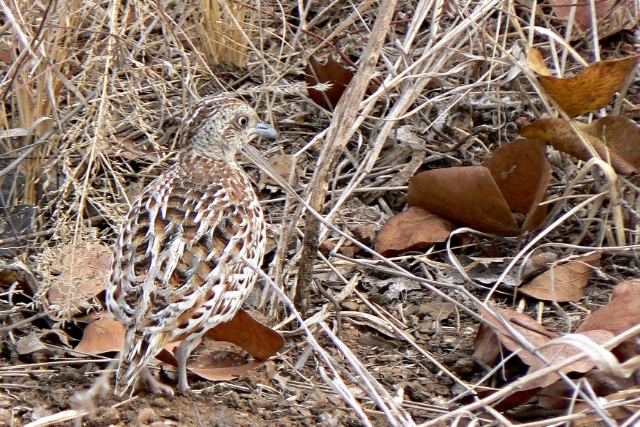
Kruger National Park, S56
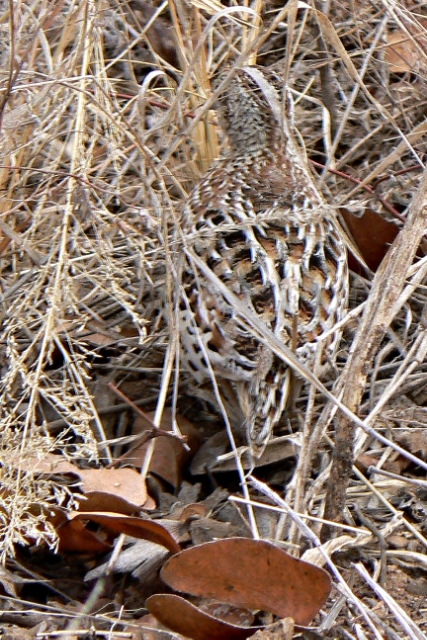
Kruger National Park, S56
 © Pumbaa
© Pumbaa
Kruger National Park, H6
 © harrys
© harrys
Kruger National Park
Links:
Newman's Birds of Southern Africa
Species Text Sabap1: http://sabap2.adu.org.za/docs/sabap1/205.pdf
Sabap2: http://sabap2.adu.org.za/spp_summary.ph ... §ion=3

Kruger National Park, S56

Kruger National Park, S56
 © Pumbaa
© PumbaaKruger National Park, H6
Kruger National Park
Links:
Newman's Birds of Southern Africa
Species Text Sabap1: http://sabap2.adu.org.za/docs/sabap1/205.pdf
Sabap2: http://sabap2.adu.org.za/spp_summary.ph ... §ion=3
Family Burhinidae (Thick-knees)
Thick-knees, also known as Dikkops or Stone-curlews, consist of nine species within the family Burhinidae, and are found throughout the tropical and temperate parts of the world, with two species found in Australia. Despite the group being classified as waders, most species have a preference for arid or semi-arid habitats.
They are medium to large birds with strong black or yellow black bills, large yellow eyes—which give them a reptilian appearance—and cryptic plumage. The names Thick-knee and Stone-curlew are both in common use, the preference among authorities for one term or the other varying from year to year. The term Stone-curlew owes its origin to the broad similarities with true curlews (which are not closely related). Thick-knee refers to the prominent joints in the long yellow or greenish legs. Obviously the heel (ankle) and the knee are confused here.
They are largely nocturnal, particularly when singing their loud wailing songs, which are reminiscent of true curlews.
The diet consists mainly of insects and other invertebrates. Larger species will also take lizards and even small mammals.
Most species are sedentary, but the Eurasian Stone Curlew is a summer migrant in the temperate European part of its range, wintering in Africa.
They are medium to large birds with strong black or yellow black bills, large yellow eyes—which give them a reptilian appearance—and cryptic plumage. The names Thick-knee and Stone-curlew are both in common use, the preference among authorities for one term or the other varying from year to year. The term Stone-curlew owes its origin to the broad similarities with true curlews (which are not closely related). Thick-knee refers to the prominent joints in the long yellow or greenish legs. Obviously the heel (ankle) and the knee are confused here.
They are largely nocturnal, particularly when singing their loud wailing songs, which are reminiscent of true curlews.
The diet consists mainly of insects and other invertebrates. Larger species will also take lizards and even small mammals.
Most species are sedentary, but the Eurasian Stone Curlew is a summer migrant in the temperate European part of its range, wintering in Africa.
Family Burhinidae (Thick-knees) Index
Species indigenous to southern Africa:
Family Burhinidae (Thick-knees)
Burhinus vermiculatus Water Thick-knee 298
Burhinus capensis Spotted Thick-knee 297
Family Burhinidae (Thick-knees)
Burhinus vermiculatus Water Thick-knee 298
Burhinus capensis Spotted Thick-knee 297
- Flutterby
- Posts: 44150
- Joined: Sat May 19, 2012 12:28 pm
- Country: South Africa
- Location: Gauteng, South Africa
- Contact:
Water Thick-Knee
298. Water Thick-Knee (Formerly known as Water Dikkop) Burhinus vermiculatus (Waterdikkop)
Order: Charadriiformes. Family: Burhinidae

Description
The Water Thick-knee is a plover-like bird with a length of about 40 cm and a wingspan of about 200 cm when fully grown. Has a large, grey/brown wing panel, narrow, white wing bar, and streaked (not spotted) upperparts. Face pattern with broad white from base of bill to below eye, dark malar and white chin and throat. The eyes are yellow or pale green; the bill is black and the legs and feet a greenish-grey. It is mainly nocturnal. Sexes are alike.
Juveniles are more vermiculated upperparts and with buff freckling on wing coverts.
At rest likely to be confused only with Spotted Thick-knee but is smaller, has a white wing bar, unspotted upperparts and a white line below and above the eye. The Spotted Thick-knee lacks the pale wing panel.
Distribution
Sub-Saharan Africa, in the lowlands from Liberia to Ethiopia discontinuously south to southern Africa. Within southern Africa it is locally common in Zimbabwe, patches of Mozambique, eastern and southern South Africa, northern and eastern Botswana and northern Namibia (including the Caprivi Strip).
Habitat
River edges and wetlands.
Movements and migrations
It is nomadic, moving in response to changing water levels.
Diet
The diet includes mainly insects, crustaceans and molluscs. It forages in a plover-like manner, repeatedly running forward a bit before pausing and jabbing at prey.
Breeding
Monogamous, solitary nester, using a simple scrape in the ground, sometimes lined with vegetation, stone chips and dry mud. It is typically placed in a fairly open position close to water. Egg-laying season is from August-January, peaking from September-December. 1-3 pale cream-coloured eggs (may be marked with brown splotches) are laid, incubated by both sexes for about 22-25 days. The chicks fledge at approximately 60-63 days old.
Call
Loud far-carrying ti-ti-ti-ti-tee-tee-teee-teeee-tooo, fading towards the end. Listen to Bird Call.
Status
Common resident in suitable habitat; undertakes local movements in response to water fluctuations. Crepuscular and nocturnal, roosts most of the day. In pairs, and in non-breeding season in loose flocks.
Order: Charadriiformes. Family: Burhinidae

Description
The Water Thick-knee is a plover-like bird with a length of about 40 cm and a wingspan of about 200 cm when fully grown. Has a large, grey/brown wing panel, narrow, white wing bar, and streaked (not spotted) upperparts. Face pattern with broad white from base of bill to below eye, dark malar and white chin and throat. The eyes are yellow or pale green; the bill is black and the legs and feet a greenish-grey. It is mainly nocturnal. Sexes are alike.
Juveniles are more vermiculated upperparts and with buff freckling on wing coverts.
At rest likely to be confused only with Spotted Thick-knee but is smaller, has a white wing bar, unspotted upperparts and a white line below and above the eye. The Spotted Thick-knee lacks the pale wing panel.
Distribution
Sub-Saharan Africa, in the lowlands from Liberia to Ethiopia discontinuously south to southern Africa. Within southern Africa it is locally common in Zimbabwe, patches of Mozambique, eastern and southern South Africa, northern and eastern Botswana and northern Namibia (including the Caprivi Strip).
Habitat
River edges and wetlands.
Movements and migrations
It is nomadic, moving in response to changing water levels.
Diet
The diet includes mainly insects, crustaceans and molluscs. It forages in a plover-like manner, repeatedly running forward a bit before pausing and jabbing at prey.
Breeding
Monogamous, solitary nester, using a simple scrape in the ground, sometimes lined with vegetation, stone chips and dry mud. It is typically placed in a fairly open position close to water. Egg-laying season is from August-January, peaking from September-December. 1-3 pale cream-coloured eggs (may be marked with brown splotches) are laid, incubated by both sexes for about 22-25 days. The chicks fledge at approximately 60-63 days old.
Call
Loud far-carrying ti-ti-ti-ti-tee-tee-teee-teeee-tooo, fading towards the end. Listen to Bird Call.
Status
Common resident in suitable habitat; undertakes local movements in response to water fluctuations. Crepuscular and nocturnal, roosts most of the day. In pairs, and in non-breeding season in loose flocks.
- Flutterby
- Posts: 44150
- Joined: Sat May 19, 2012 12:28 pm
- Country: South Africa
- Location: Gauteng, South Africa
- Contact:
Water Thick-Knee Photos
298. Water Thick-Knee (Formerly known as Water Dikkop) Burhinus vermiculatus
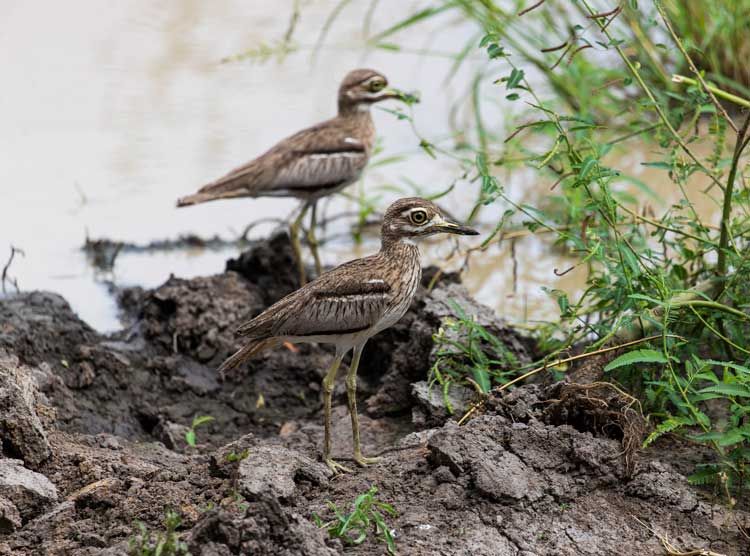 © Pumbaa
© Pumbaa
Kruger National Park, Gardenia Hide, Feb 2020
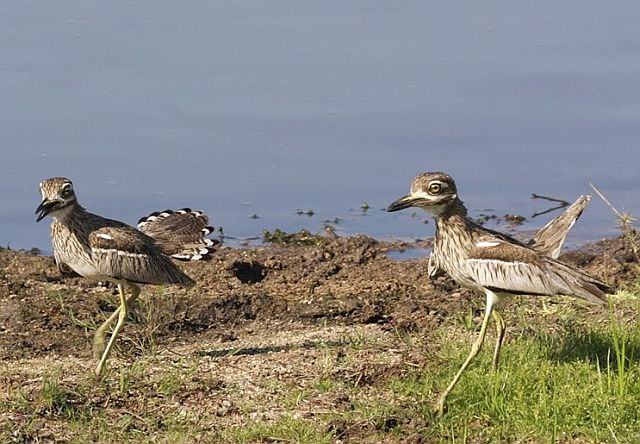 © leachy
© leachy
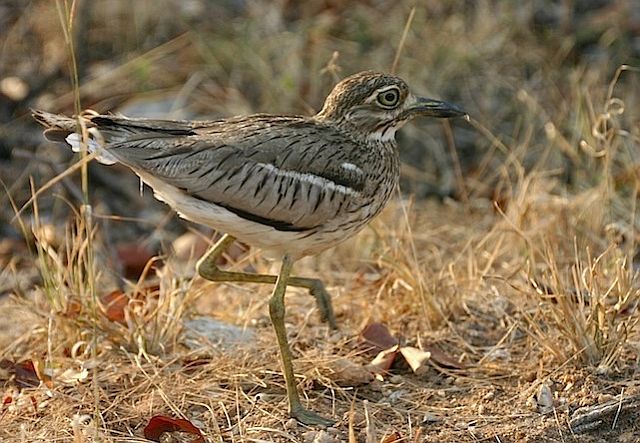 © ExFmem
© ExFmem
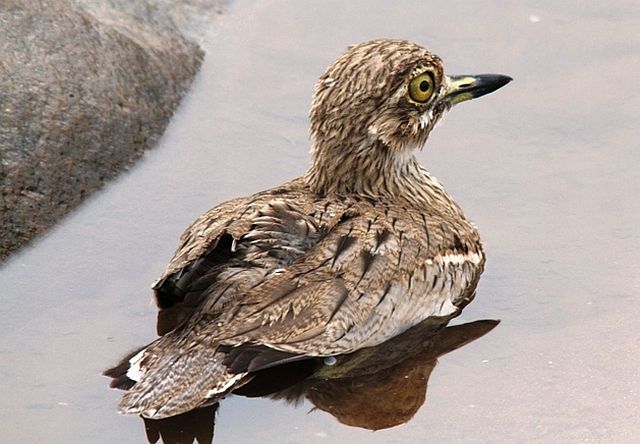 © pooky
© pooky
Links:
Sasol
 © Pumbaa
© PumbaaKruger National Park, Gardenia Hide, Feb 2020
 © leachy
© leachy © ExFmem
© ExFmem © pooky
© pookyLinks:
Sasol
-
Tshukudu
- Posts: 743
- Joined: Fri Jun 01, 2012 5:50 am
- Country: South Africa
- Location: Here but not all There
- Contact:
Spotted Thick-Knee
297. Spotted Thick-Knee (Formerly known as Spotted Dikkop) Burhinus capensis (Gewone Dikkop)
Order: Charadriiformes. Family: Burhinidae

Description
34 cm. It has large eyes and yellow legs with three toed, webbed feet. It has a brown-and-white speckled coat (A brownish black streaks on head and back, a dark brown streak appears from under the eye to the ear covers and a white streak stretches below the eye to the cheek. The upperparts and wings have brown, white and black splotches. Wings are brown and grey, tipped with black and have white edges surrounding them. The underparts and throat are white, the breast is light brown with black streaks.). In flight two white patches at the tip of the wing is visible. The underside of the bird is light yellow-brown and also spotted. Sexes similar.
Juveniles have grey freckled wing-coverts and a slightly vermiculated tail and upperparts.
Similar species: It may be distinguished from the Water Thick-knee by its spotted back and the lack of a wing bar.
Distribution
It ranges widely through sub-Saharan Africa. In southern Africa it is fairly common across much of the region, largely excluding Lesotho, southern Namibia and central and northern Mozambique.
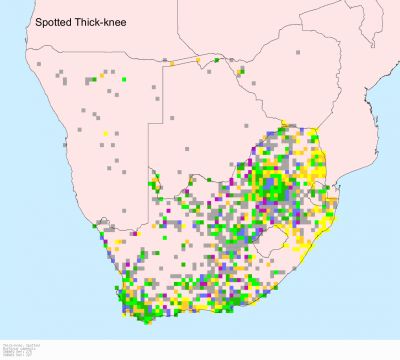
Habitat
Favours stony open savanna and grassland; also occurs in urban parks and gardens, and on beaches.
Behaviour
Gregarious in flocks of up to 40-50 birds in non-breading season. Largely nocturnal.
Diet
The species hunts exclusively on the ground. Spotted Thick-knees feed mainly on termites, grasshoppers, beetles and other invertebrates. Occasionally they will eat reptiles or small mammals.
Breeding
The Spotted Thick-knee nests on the ground, lining a scrape with grasses, feathers, pebbles and twigs. The female typically lays two eggs. Incubation period is about 24 days. Males and females rear offspring together, with both bringing food back to the nest. Spotted Thick-knees are very aggressive in defending their nests. The birds will also fake injury to lead predators away from the nest. Typical breeding period is spring or early summer.
Call
The Spotted Thick-knee has several calls which may be described as tchee-youuu, ti-ti-ti-ti-tee-tee-teee-teeee, fading towards the end and whee-you-ee. Normally silent during the day. Their call has an eerie, ghost-like, quality. Listen to Bird Call.
Status
Fairly common resident.
Order: Charadriiformes. Family: Burhinidae

Description
34 cm. It has large eyes and yellow legs with three toed, webbed feet. It has a brown-and-white speckled coat (A brownish black streaks on head and back, a dark brown streak appears from under the eye to the ear covers and a white streak stretches below the eye to the cheek. The upperparts and wings have brown, white and black splotches. Wings are brown and grey, tipped with black and have white edges surrounding them. The underparts and throat are white, the breast is light brown with black streaks.). In flight two white patches at the tip of the wing is visible. The underside of the bird is light yellow-brown and also spotted. Sexes similar.
Juveniles have grey freckled wing-coverts and a slightly vermiculated tail and upperparts.
Similar species: It may be distinguished from the Water Thick-knee by its spotted back and the lack of a wing bar.
Distribution
It ranges widely through sub-Saharan Africa. In southern Africa it is fairly common across much of the region, largely excluding Lesotho, southern Namibia and central and northern Mozambique.

Habitat
Favours stony open savanna and grassland; also occurs in urban parks and gardens, and on beaches.
Behaviour
Gregarious in flocks of up to 40-50 birds in non-breading season. Largely nocturnal.
Diet
The species hunts exclusively on the ground. Spotted Thick-knees feed mainly on termites, grasshoppers, beetles and other invertebrates. Occasionally they will eat reptiles or small mammals.
Breeding
The Spotted Thick-knee nests on the ground, lining a scrape with grasses, feathers, pebbles and twigs. The female typically lays two eggs. Incubation period is about 24 days. Males and females rear offspring together, with both bringing food back to the nest. Spotted Thick-knees are very aggressive in defending their nests. The birds will also fake injury to lead predators away from the nest. Typical breeding period is spring or early summer.
Call
The Spotted Thick-knee has several calls which may be described as tchee-youuu, ti-ti-ti-ti-tee-tee-teee-teeee, fading towards the end and whee-you-ee. Normally silent during the day. Their call has an eerie, ghost-like, quality. Listen to Bird Call.
Status
Fairly common resident.
-
Tshukudu
- Posts: 743
- Joined: Fri Jun 01, 2012 5:50 am
- Country: South Africa
- Location: Here but not all There
- Contact:
Spotted Thick-Knee Photos
297. Spotted Thick-Knee (Formerly known as Spotted Dikkop) Burhinus capensis (Gewone Dikkop)

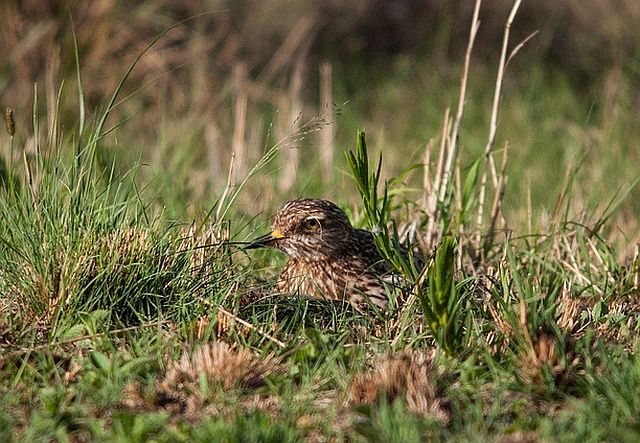 © Joan
© Joan
Rietvlei Nature Reserve, Gauteng
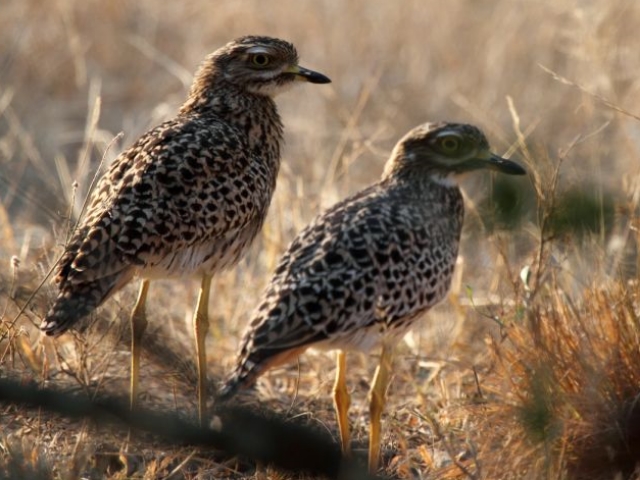 © Duke
© Duke
Kruger National Park
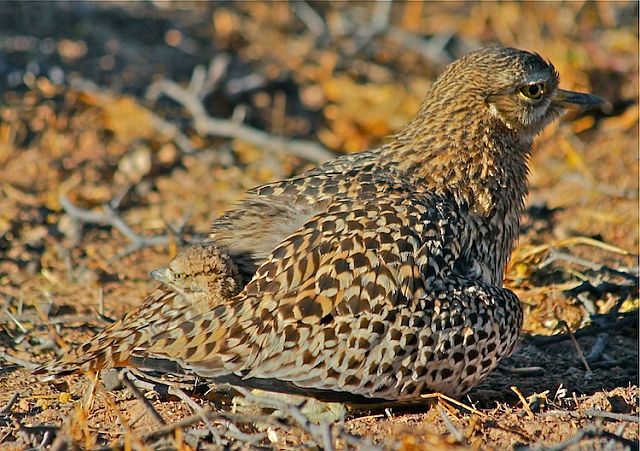 © ExFmem
© ExFmem
 © ExFmem
© ExFmem
 © ExFmem
© ExFmem
Links:
http://sabap2.adu.org.za/docs/sabap1/297.pdf
http://sabap2.adu.org.za/species_info.p ... #menu_left
Sasol

 © Joan
© JoanRietvlei Nature Reserve, Gauteng
 © Duke
© DukeKruger National Park
 © ExFmem
© ExFmem © ExFmem
© ExFmem © ExFmem
© ExFmemLinks:
http://sabap2.adu.org.za/docs/sabap1/297.pdf
http://sabap2.adu.org.za/species_info.p ... #menu_left
Sasol
Family Haematopodidae (Oystercatchers)
Family Haematopodidae (Oystercatchers)
The oystercatchers are a group of waders forming the family Haematopodidae, which has a single genus, Haematopus. They are found on coasts worldwide apart from the polar regions and some tropical regions of Africa and South East Asia. The exception to this is the Eurasian Oystercatcher and the South Island Oystercatcher, both of which breed inland, far inland in some cases.
The different species of oystercatcher show little variation in shape or appearance. They range from 39–50 cm in length and 72–91 cm in wingspan. The plumage of all species is either all-black, or black on top and white underneath. They are large, obvious, and noisy plover-like birds, with massive long orange or red bills used for smashing or prying open molluscs. The bill shape varies between species, according to the diet. Those birds with blade-like bill tips pry open or smash mollusc shells, and those with pointed bill tips tend to probe for annelid worms. They show sexual dimorphism, with females being longer-billed and heavier than males.
The diet of oystercatchers varies with location. Species occurring inland feed upon earthworms and insect larvae. The diet of coastal oystercatchers is more varied, although dependent upon coast type; on estuaries bivalves, gastropods and polychaete worms are the most important part of the diet, whereas rocky shore oystercatchers prey upon limpets, mussels, gastropods, and chitons.
There is strong mate and site fidelity in the species that have been studied, with one record of a pair defending the same site for 20 years. The nests of oystercatchers are simple affairs, scrapes in the ground which may be lined, and placed in a spot with good visibility. The eggs of oystercatchers are spotted and cryptic. Between one and four eggs are laid. Incubation is shared but not proportionally, females tend to take more incubation and males engage in more territory defence. Oystercatchers are also known to practice "egg dumping." Like the cuckoo, they sometimes lay their eggs in the nests of other species such as seagulls, abandoning them to be raised by those birds.
The oystercatchers are a group of waders forming the family Haematopodidae, which has a single genus, Haematopus. They are found on coasts worldwide apart from the polar regions and some tropical regions of Africa and South East Asia. The exception to this is the Eurasian Oystercatcher and the South Island Oystercatcher, both of which breed inland, far inland in some cases.
The different species of oystercatcher show little variation in shape or appearance. They range from 39–50 cm in length and 72–91 cm in wingspan. The plumage of all species is either all-black, or black on top and white underneath. They are large, obvious, and noisy plover-like birds, with massive long orange or red bills used for smashing or prying open molluscs. The bill shape varies between species, according to the diet. Those birds with blade-like bill tips pry open or smash mollusc shells, and those with pointed bill tips tend to probe for annelid worms. They show sexual dimorphism, with females being longer-billed and heavier than males.
The diet of oystercatchers varies with location. Species occurring inland feed upon earthworms and insect larvae. The diet of coastal oystercatchers is more varied, although dependent upon coast type; on estuaries bivalves, gastropods and polychaete worms are the most important part of the diet, whereas rocky shore oystercatchers prey upon limpets, mussels, gastropods, and chitons.
There is strong mate and site fidelity in the species that have been studied, with one record of a pair defending the same site for 20 years. The nests of oystercatchers are simple affairs, scrapes in the ground which may be lined, and placed in a spot with good visibility. The eggs of oystercatchers are spotted and cryptic. Between one and four eggs are laid. Incubation is shared but not proportionally, females tend to take more incubation and males engage in more territory defence. Oystercatchers are also known to practice "egg dumping." Like the cuckoo, they sometimes lay their eggs in the nests of other species such as seagulls, abandoning them to be raised by those birds.
Family Haematopodidae (Oystercatchers) Index
Species indigenous to southern Africa:
Family Haematopodidae (Oystercatchers)
Haematopus moquini African Oystercatcher 244
Haematopus ostralegus Eurasian Oystercatcher 243
Family Haematopodidae (Oystercatchers)
Haematopus moquini African Oystercatcher 244
Haematopus ostralegus Eurasian Oystercatcher 243


